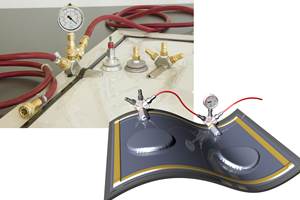High-performance fibers
High-strength fibers used in advanced composites include not only carbon, glass and aramid, but high-modulus polyethylene (PE), boron, quartz, ceramic, newer fibers such as poly p-phenylene-2,6-benzobisoxazole (PBO), and hybrid combinations, as well. The basic fiber forms for high-performance composite applications
High-strength fibers used in advanced composites include not only carbon, glass and aramid, but high-modulus polyethylene (PE), boron, quartz, ceramic, newer fibers such as poly p-phenylene-2,6-benzobisoxazole (PBO), and hybrid combinations, as well. The basic fiber forms for high-performance composite applications are bundles of continuous fibers called tows. A carbon fiber tow consists of thousands of continuous, untwisted filaments, with the filament count designated by a number followed by "K,"indicating multiplication by 1,000 (e.g., 12K indicates a filament count of 12,000). Tows may be used directly, in processes such as filament winding or pultrusion, or may be converted into unidirectional tape, fabric and other reinforcement forms.
Carbon fiber - by far the most widely used fiber in high-performance applications - is produced from a variety of precursors, including polyacrylonitrile (PAN), rayon and pitch. The precursor fibers are heated and stretched to create the high-strength fibers. The first high-performance carbon fibers on the market were made from rayon precursor. PAN- and pitch-based fiber have replaced rayon-based fiber in most applications, but the latter's "dogbone"cross-section often make it the fiber of choice for carbon/carbon (C/C) composites. PAN-based carbon fibers are the most versatile and widely used. They offer an amazing range of properties, including excellent strength - to 1,000 ksi - and high stiffness. Pitch fibers, made from petroleum or coal tar pitches, have high to extremely high stiffness and low to negative axial CTE. Their CTE properties are especially useful in spacecraft applications that require thermal management, such as electronic instrumentation housings.
Typical aerospace-grade tow size ranges from 1K to 12K. PAN- and pitch-based 12K carbon fibers are available with a moderate (33 to 35 Msi), intermediate (40 to 50 Msi), high (50 to 70 Msi) and ultrahigh (70 to 140 Msi) modulus. (Modulus is the mathematical value that describes the stiffness of a material by measuring its deflection or change in length under loading.) Newer heavy-tow carbon fibers, with filament counts from 48K to 320K, are available at a lower cost than aerospace-grade fibers. They typically have a 33- to 35-Msi modulus and 550-ksi tensile strength and are used when fast part build-up is required, most commonly in recreational, industrial, construction and automotive markets. Heavy-tow fibers exhibit properties that approach those of aerospace-grade fibers but can be manufactured at a lower cost because of precursor and processing differences.
Though stronger than glass or aramid fibers, carbon fibers are not only less impact-resistant but also can experience galvanic corrosion when in contact with metal. Fabricators overcome the latter problem by using a barrier material or veil ply - often fiberglass/epoxy - during laminate layup.
Aramid fibers, composed of aromatic polyamide, provide exceptional impact resistance and tensile strength. Standard high-performance aramid fiber has a modulus of about 20 Msi and tensile strength of approximately 500 ksi. Renowned for performance in bulletproof vests and other armor and ballistic applications, the fiber has been in increasing demand, due, in part, to growth of the personnel protection and military armor markets spurred by conflicts around the world. Aramid's properties also make the fiber an excellent choice for helicopter rotor blades, solid rocket motors, compressed natural gas (CNG) tanks and other parts that must withstand high stress and vibration.
Commercially available high-strength, high-modulus polyethylene (PE) fibers are known for their extremely light weight, excellent chemical and moisture resistance, outstanding impact resistance, antiballistic properties and low dielectric constant. However, PE fibers have relatively low resistance to elongation under sustained loading, and the upper limit of their use temperature range is about 98°C/210°F. PE fiber composites are used in racing boat hulls, ski poles, offshore mooring ropes and other applications that require impact and moisture resistance and light weight, but do not necessitate extreme temperature resistance. At least one aircraft manufacturer now uses high-modulus PE fibers for the bulletproof insert in aircraft cockpit doors.
Related Content
GKN Aerospace, Joby Aviation sign aerostructures agreement
GKN Aerospace will manufacture thermoplastic composite flight control surfaces for Joby’s all-electric, four-passenger, composites-intensive ride-sharing aircraft.
Read MoreCOMPINNOV TP2 project promotes use of thermoplastics in aerospace
Completed in 2023, COMPINNOV TP2 explored thermoplastic composites, enhancing the understanding between prepregs and production methods to foster the potential for French aerospace innovation.
Read MoreComposite resins price change report
CW’s running summary of resin price change announcements from major material suppliers that serve the composites manufacturing industry.
Read MoreSmartValves offer improvements over traditional vacuum bag ports
Developed to resolve tilting and close-off issues, SmartValves eliminate cutting through vacuum bags while offering reduced process time and maintenance.
Read MoreRead Next
Plant tour: Daher Shap’in TechCenter and composites production plant, Saint-Aignan-de-Grandlieu, France
Co-located R&D and production advance OOA thermosets, thermoplastics, welding, recycling and digital technologies for faster processing and certification of lighter, more sustainable composites.
Read MoreVIDEO: High-volume processing for fiberglass components
Cannon Ergos, a company specializing in high-ton presses and equipment for composites fabrication and plastics processing, displayed automotive and industrial components at CAMX 2024.
Read MoreAll-recycled, needle-punched nonwoven CFRP slashes carbon footprint of Formula 2 seat
Dallara and Tenowo collaborate to produce a race-ready Formula 2 seat using recycled carbon fiber, reducing CO2 emissions by 97.5% compared to virgin materials.
Read More














.jpg;maxWidth=300;quality=90)







